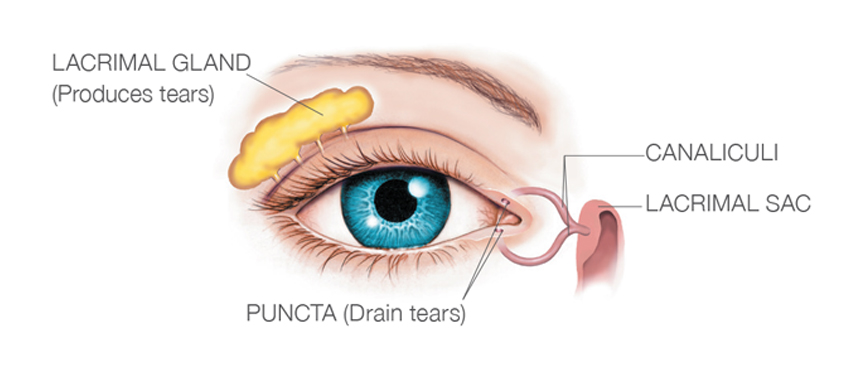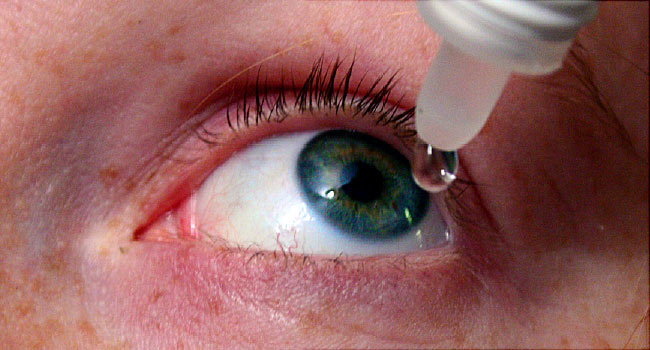What is Dry eye syndrome?
Dry eye syndrome is a chronic, long-term condition which develops due to multiple factors which leads to decreased tear film or poor-quality tear film.
There is a tear film which forms a film over our eye and protects and nourishes the anterior surface of the eye. This tear film is formed by three layers:
- The outermost is the oily layer. Our eyelids have small glands called sebaceous glands, which secrete the oils each time we blink and spread it evenly across the cornea.
- Next is the watery layer in the middle. This is produced by the lacrimal glands.
- Inner most is the mucin layer. This is secreted by the goblet cells.
All three of them need to be working together to provide the best quality tear film.
How is Dry eye syndrome caused?
There can be various reasons for dry eyes.  Like, the under production of tears. Or maybe the tear quality is just not good enough. And often, a combination of both. This is termed tear film instability. Causes for this instability are Meibomian Gland dysfunction, Corneal Surgery, Contact Lens wear, seasonal allergies, Systemic Diseases and long term use of certain eye drops (anti glaucoma).
Like, the under production of tears. Or maybe the tear quality is just not good enough. And often, a combination of both. This is termed tear film instability. Causes for this instability are Meibomian Gland dysfunction, Corneal Surgery, Contact Lens wear, seasonal allergies, Systemic Diseases and long term use of certain eye drops (anti glaucoma).
Why are tears important?
A smooth layer of tears is essential for sharp vision. If the tear film has patchy areas where it has dried out, the light that hits the eye is scattered and does not focus clearly. A patchy, poor quality tear film also leads to discomfort and irritation.
What are the symptoms of Dry eye syndrome?
- Burning sensation and itching (Specially when exposed to increased evaporative conditions like heat, AC, prolong reading).
- Pricking sensation/ Foreign body sensation.
- Blurring of vision (especially at the end of the day).
- Redness and watering of eyes.
- Photophobia.
- Symptoms persists even after removing Contact lenses.
Patient’s experience of the disease may be far more uncomfortable than it appears to a clinician when examining the clinical sign.
Who is at risk of developing Dry eye syndrome?
- Persons over 60 years of age
- Women in general have higher chances
- People who frequently use computer and video screens
- Lack of sleep and excessive stress
- Users of certain medications like anti-glaucoma drops, antihistamines and anti-depressants
- Long term contact lens users
How is Dry eye syndrome treated?
First the cause of decreased tear film is identified. Depending on the cause and severity, Ophthalmologist will advise the course of treatment. Treatment options are:
Artificial tears
- Artificial tears are eye drops used as a
 replacement for watery tears. Gels and ointments are also available, and are thicker than eye drops. (Gels usually last longer in the eye and need to be put in less frequently, but can blur the vision.)
replacement for watery tears. Gels and ointments are also available, and are thicker than eye drops. (Gels usually last longer in the eye and need to be put in less frequently, but can blur the vision.) - Preservative-free eye drops are recommended for use with contact lenses, or if they are needed more than four times a day.
- Expressing natural oily tears to the ocular surface by daily hot eyelid massage can reduce the frequency of artificial tear drops required
Antiglaucoma drops
- Switching to preservative-free glaucoma eye drops is recommended for patients with glaucoma who also have dry eye syndrome.
Anti-inflammatory agents
- Steroid eye drops or topical ciclosporin eye drops may be prescribed by an ophthalmologist if the dry eye condition has led to inflammation of the surface of the eye
Prevention of excessive drainage
- When there is lack of watery (aqueous) tears, punctal plugs can be inserted into the tear duct (puncta) to stop tears from draining away and keep them on the surface of the eye for longer. It is a reversible procedure.
- If the plugs help your dry eye but fall out, then punctal cautery can be considered. This is a permanent procedure.
- Switching to preservative-free glaucoma eye drops is recommended for patients with glaucoma who also have dry eye syndrome.
Anti-inflammatory agents
- Steroid eye drops or topical ciclosporin eye drops may be prescribed by an ophthalmologist if the dry eye condition has led to inflammation of the surface of the eye
Prevention of excessive drainage
- When there is lack of watery (aqueous) tears, punctal plugs can be inserted into the tear duct (puncta) to stop tears from draining away and keep them on the surface of the eye for longer. It is a reversible procedure.
- If the plugs help your dry eye but fall out, then punctal cautery can be considered. This is a permanent procedure.
How to prevent dry eye syndrome?
- Drink lots of water, as this helps improve tear production
- Get enough sleep each night
- Avoid alcohol or spicy foods, as these can cause meibomian oil gland blockage
- Avoid smoking or smoky areas as this makes the eyes drier
- Wear glasses or sunglasses on windy days to protect your eyes from the wind
- Avoid air-conditioned environments and draughts near your face, and consider using a humidifier to put more water into the air
- Remember to blink more frequently when using a computer screen or reading, and look far away (20 feet) from the screen for a break every 20 minutes, for 20 secs (20-20-20 rule)